
surfresearch.com.au
pt, mr, and midget : design, 1977.
pt, mr, and midget : design, 1977.
|
|
|
|
|
|
 |
surfresearch.com.au
pt, mr, and midget : design, 1977. |
|
I never really did get into the super shorties when they were happening way back in the late-sixties. I think the shortest I ever went was five-ten, many people went down into the low fives. Short stubbies and twin-finners were the go, who can forget Dappa's four-ten twin spinner. After flashing on a shot of Mark Crowl flying off the lip on a Fish in Surfer magazine I've always said to myself "one of these days I've got to make me one of those". The first lime I ever competed against the Fishes was at the World Contest in San Diego in 72. David Nuuihwa and Jim Blears piloted their Fishes into the two top places, while I managed a third on conventional equipment. I was not overly impressed by their Fish performances in zero to three foot conditions, but they beat me, so there must have been something in them worth considering. |
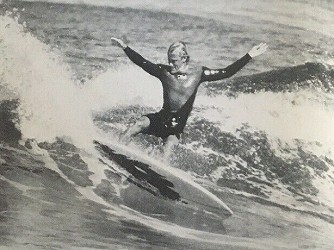 The idea of
specialised small wave boards
hits home as P.T. cranks back. Photo: Core |
| The final
inspiration came while surfing around California
early last year and checking out Skip Frye's fleet
of little Fishes at Gordon & Smith in San Diego.
Immediately I flashed on a perfect little combo with small summer conditions and Sandshoes Reef in mind. Stage 1: I built my first Fish soon after, adding a few creative variations. I made it 5ft 8" x 21 1/2" and the first Purple Flyer Page 14 was born. I also made one for Ross Longbollom. I was ready for my first session, I launched my first attack on some Pipe rights in April 75 on the south coast. The speed surprised the shit out of me and I couldn't even cut it back. It was a whole different trip, all that planing area was getting me up and away, like being permanently on the nose but still having the freedom to manoeuvre wherever your mind wanted to go. It was an incredible feeling to experience for the first time. I suddenly had a renewed interest in the approach of other short board and Fish exponents. Leafing back through my surf magazine collection and becoming engrossed in the moves of lung lime Fishermen like Florida's Mike Tabeling and a re-examination of David Nuuhiwa's attack on the Rocky Point lefts during the 73 Expression Session. Getting stoked on those full forward trim shots and being able to defy gravity by flying along the lace, fly-papered on the wall. Last year I even pulled the Purple Flyer out of the quiver to skate over Narrabeen's littlies during the 2SM-Coke content, but it didn't impress the Judges. A lot of people said it was the board, but it wasn't, Reno Abellira proved that this year by holding down a top spot with some hot Fish manoeuvring, last year I had only been riding the Fish a month before the contest and was sure into exploring new techniques in riding, rather than trying to surf to suit the judging system. I kept the Purple Flyer right through until the Hawaiian winter of 75-76, when I decided it was time for a few improvements. Stage 2: TheTwin-stringer (sic: stinger?) Firebreather. I added a couple more inches to the length and pulled the planshape in a little. I also made the tail finer, giving it more bite for working on a new cutback. Had a few hot sessions before heading off to South Africa and it was just starting to come together. Arriving home and spending a few days surfing sleek peaks at Garie, beginning to find the right line and temperament. The harder I pushed it, the more it hung in there. But it sure wouldn't go backside, though I guess the rest of the quiver covers on those occasion. It took some lime but I really began to truly master riding the ... |
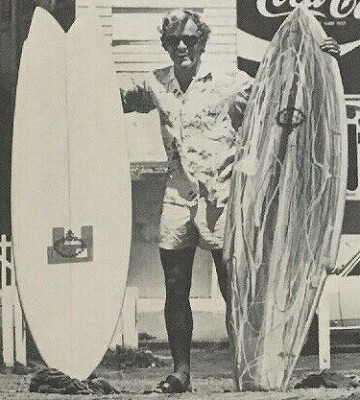 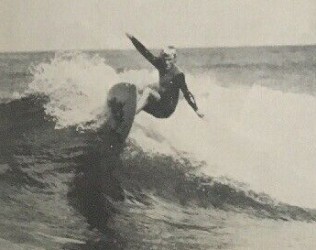 |
|
Page 17
The $8000 SurfboardAs we go through the seasons and surf many different surfboards, we often become sentimentally attached to favourite boards. Most you like, some you don't like and occasionally you find an extra hot one that suits your own style of surfing particularly well. To a surfer, a good surfboard means a lot, so when you find one you try to keep it as long as possible. The quest to find a good board can be endless, depending of course on your sensitivity. For example, last winter in Hawaii Ian Cairns and Rabbit Bartholomew had a fleet of 23 surfboards between the two of them to select from. The 'Quiver Theory' has become a must for all professional surfers. There is no such thing as the perfect surfboard for all conditions. You need a range of surfboards to suit all types of waves. |
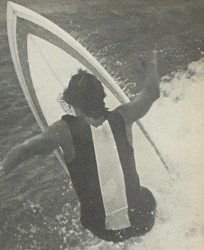 |
| Page 18 Stinger in the first place. "Well, during the early part of 74, Ronny Romero was writing to me from Hawaii and in every letter would tell me how much Larry Bertleman was ripping on his new Stingers that Ben Apia had shaped for him. I decided that I'd like to try one, so when I was in Hawaii for the winter of 74-75 I met Ben Apia out in the surf and told him I wanted to order a Stinger from him. He said the best thing was to have a surf on one first, but after waiting for about three weeks to surf one I just went to his shop and ordered one. I paid full price for it, I think it was about 200 American dollars." So you've been surfing it for two years now, what would you say it's most out-standing features were? "It's loose and last, last year I got Ben to shape me a new one exactly the same and he put bevelled rails on it and it was too loose- and fast. I've had this one in surf up to 12 feet, but I've found it goes best in surf around six feet." This one is heading back for its third season in the Islands, it's getting pretty knocked around now, how much longer can it last? "Not long, that's for sure. The tail has been broken off twice now by legropes, both times at Merewhether. The deck has delaminated and has gone all bubbly. I'm taking it back so Ben can shape me two more exactly the same." |
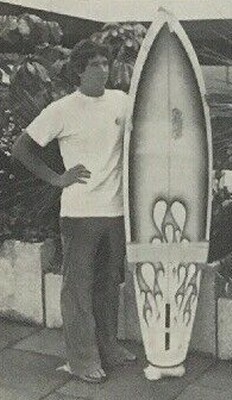 Photo:
Steve Core
|
|
Midget Farrelly
Design and Performance Hang gliders and Surfboards Is there a relationship between surfboard and hang-glider design? Surfboards have been around for hundreds of years but then so have hang-gliders. How come both of them are only achieving popularity now in the last ten years? Modern materials are the answer. Foam and fibreglass have replaced heavy wood in surf-boards and aluminium and dacron have done the same for hang-gliders. |
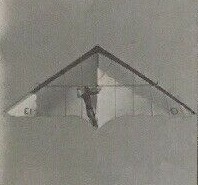 Photo:
Simmons
|
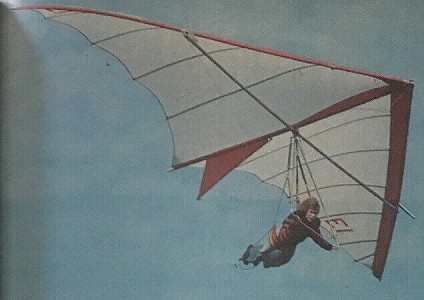 |
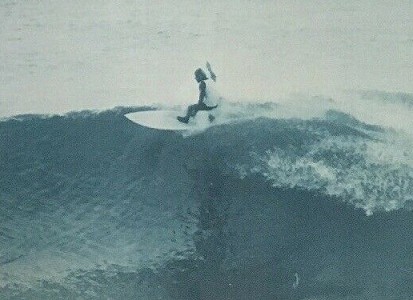 |
|
|
|
|
|
|